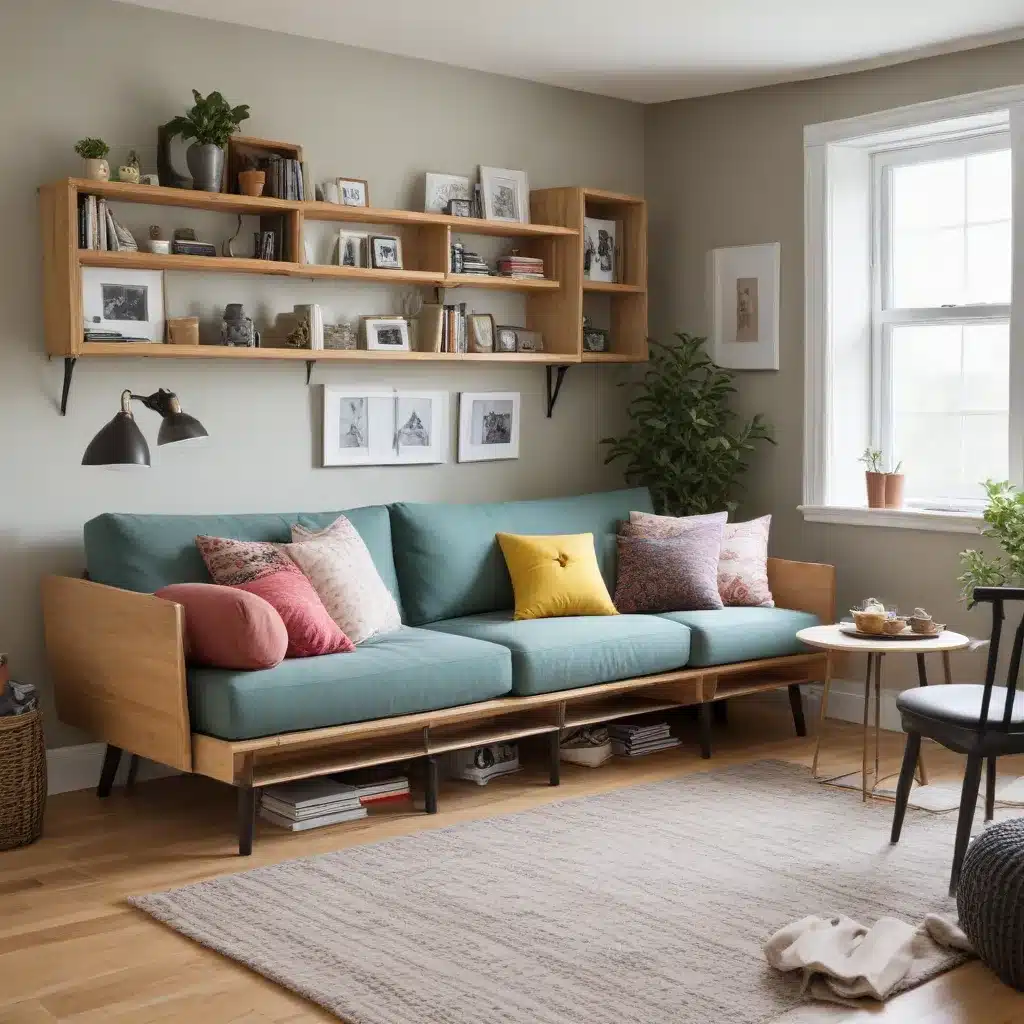
Repurposing Furniture for Multifunctional Living
As an experienced home improvement consultant, I’ve seen countless families struggle with the challenge of maximizing limited living space. However, with a little creativity and the right repurposing strategies, you can transform your home into a multifunctional oasis that caters to your unique lifestyle. In this comprehensive guide, we’ll explore innovative ways to breathe new life into your existing furniture, unlock hidden storage potential, and create flexible living areas that adapt to your evolving needs.
Furniture Transformation Strategies
Oftentimes, the key to a clutter-free, efficiently designed home lies in repurposing the very items you already own. By thinking outside the box and embracing repurposing, you can create a cohesive, personalized living space that serves multiple functions without breaking the bank.
Repurposing Household Items
Look around your home with a fresh perspective – that old dresser, bedside table, or even a ladder can be reimagined into a stunning focal point or a practical storage solution. For example, a tall dresser can be transformed into a display cabinet for your favorite decor items, while a vintage suitcase can become a unique side table with hidden storage inside.
Upcycling Vintage Pieces
Don’t be afraid to breathe new life into cherished vintage or antique furniture. A lick of paint, some thoughtful hardware swaps, and a little elbow grease can turn an outdated piece into a stunning, multifunctional centerpiece. Consider upcycling a sideboard into a sleek media console, or transforming a weathered trunk into a stylish coffee table with storage.
Modular Furniture Solutions
Modular furniture offers a flexible and space-saving approach to living. From convertible sofas that transform into guest beds to nesting tables that tuck away when not in use, these innovative designs allow you to customize your space as your needs evolve. Invest in a multifunctional ottoman that can serve as a coffee table, extra seating, or hidden storage, and watch your living room transform.
Maximizing Small-Space Efficiency
Whether you live in a cozy apartment or a larger family home, maximizing small-space efficiency is key to creating a harmonious, clutter-free living environment. By incorporating dual-purpose furnishings, clever storage solutions, and flexible room designs, you can unlock the full potential of your square footage.
Dual-Purpose Furnishings
When space is limited, every piece of furniture must earn its keep. Seek out multipurpose pieces that combine form and function, such as a storage ottoman that serves as a coffee table and hidden storage, or a console table that doubles as a work-from-home desk. By choosing versatile, streamlined furniture, you can minimize visual clutter and create a more open, airy atmosphere.
Space-Saving Storage Options
Innovative storage solutions are the linchpin of a well-organized, multifunctional living space. Explore floating shelves, wall-mounted cabinets, and under-bed drawers to maximize vertical space and keep essentials within reach. Repurpose vintage trunks or decorative baskets to conceal off-season clothing, linens, and other household items.
Flexible Room Designs
Embrace the concept of multipurpose living by designing flexible, adaptable spaces. Consider a convertible sofa that transforms into a guest bed, or a transforming coffee table that lifts to become a dining surface. Strategically place rolling carts or mobile storage units to easily rearrange your living area as needed, whether you’re hosting a family gathering or creating a cozy movie-watching nook.
Sustainable Design Principles
As eco-conscious consumers, many of us are seeking ways to reduce our environmental impact while creating beautiful, functional living spaces. By incorporating sustainable design principles, you can enjoy the benefits of multifunctional living while contributing to a more responsible future.
Eco-Friendly Materials
When selecting new furniture or decor, prioritize sustainable, eco-friendly materials such as reclaimed wood, natural fiber fabrics, and low-VOC paints. These choices not only reduce your carbon footprint but also contribute to a healthier indoor environment for your family.
Minimalist Approach
A minimalist design approach can work hand in hand with multifunctional living. By paring down your possessions and embracing streamlined, versatile furniture, you can create a living space that is both visually appealing and environmentally responsible. This mindset encourages you to thoughtfully curate your belongings and maximize the use of each item.
Circular Economy Concepts
Embrace the principles of the circular economy by repurposing, upcycling, and extending the lifespan of your existing furniture. This not only reduces waste but also encourages a more sustainable, mindful approach to home design. When it’s time to part with an item, consider donating, selling, or responsibly recycling it to keep it out of landfills.
Personalized Living Experiences
Your home is a reflection of your unique lifestyle and personal preferences. By incorporating customizable layouts, multitasking furniture, and lifestyle-driven adaptations, you can create a living space that truly caters to your family’s needs.
Customizable Layouts
Experiment with flexible furniture arrangements to discover the layout that best suits your daily routine. Arrange your sectional sofa to create a cozy conversation area, then easily reconfigure it to accommodate a larger gathering. Explore modular shelving systems that allow you to customize the configuration as your storage needs evolve.
Multitasking Furniture
Seek out multipurpose furniture that can adapt to your changing needs. A height-adjustable desk can serve as a workspace, a dining table, or even a play surface for your children. A convertible ottoman that transforms into extra seating or a coffee table is a game-changer for small-space living.
Lifestyle-Driven Adaptations
Design your living space to seamlessly integrate with your family’s unique lifestyle and routines. Incorporate hidden storage solutions to conceal homeschooling supplies, workout equipment, or hobby materials. Strategically place charging stations and media cabinets to keep your tech essentials organized and within reach.
As you embark on your journey to create a more multifunctional living space, remember to embrace your creativity, stay open to experimentation, and prioritize solutions that cater to your family’s evolving needs. By repurposing existing furniture, incorporating sustainable design principles, and customizing your living experience, you can transform your home into a streamlined, versatile, and deeply personal sanctuary. For more inspiration and expert insights, be sure to visit https://www.reluctantrenovator.com.



